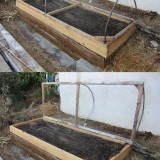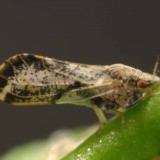
UPDATE: This idea is a complete failure–see the ugly details here.
Last month I sang the praises of floating row cover as an insect barrier. The only problem is that floating row cover retains heat, and so when our fall and winter days turn hot, as they so often do, it gets way too hot and humid inside the “tent.” So as Marshall McLuhan was fond of saying, “If you don’t like that idea, I’ve got others.” Specifically, bird netting.
I’ve got an untested theory that bird netting is enough to keep out the white butterflies that give birth to the dreaded cabbage leaf caterpillar, the only serious pest for us at this time of year. So far the bird netting seems to be working. I’ll note that it would be important to keep the leaves of plants well away from the netting so that butterflies can’t lay eggs through it. The best way to do this is by planting arches of wire or tubing over your garden bed, and stretching the cover material over those arches– like a covered wagon.
Netting has advantages over row cover: you can see and water through it and it’s more readily available.
I’m curious what you, our dear readers, think of the idea?
- Mrs. Homegrown chimes in: I’ll add that in the past readers have said they use tulle material as an insect barrier– you know, the stuff used to make tutus.






When I’m working in the garden (which is quite often!) I keep an old tennis racket handy. When I see a cabbage moth flying I give it a whack. You’d be surprised how many I kill in a season. It’s also helped my forehand!
That is interesting! I would love to try it. I hate the idea of keeping the netting off the leaves though. I would have to try it on something small because our collards, mustards, and other greens get HUGE and I would have to build something huge. I do like the idea of the tennis racket but we are an hour away from our garden and only make it up there twice a week. One time I did snatch one out of the air like a ninja but one out of a million really doesn’t make that much of a difference so we have to figure something else out 😉 If we try the netting I will let you know how it goes!
I keep hoops over my garden through out the winter season with (1) a layer of plastic screening and (2) a layer of frost blanket type material. I can toss back all layers, some layers or no layers depending on weather. The screening deters insects, allows sun and rain, and provides a little shade when it gets hot. it also provides a little support should we get snow so the frost blanket doesn’t just settle down on the plants. When its hard frost/freeze time, the two layers protect the garden totally. Clothespins (clip type) are used to hold these layers down and closed when necessary.
Love your new format-so much easier to navigate around and figure out!
Yes, tulle is good to use as an insect barrier.
Ah, this is brilliant! I really hope this works, because this could be a major savior for me. Please let us know how it goes!
In the fabric section there are two similar fabrics–tulle and net. Net is cheaper. It should be as effective as tulle, the fabric for bridal veils as well as tutus.
Ah!! Such a great idea! I used floating row cover last year and it worked great in that my plants were bug free. However, I didn’t like not being able to see what was going on, weeding was (more of) a pain, and watering was also difficult. I really like this idea (or tulle). Let us know how it works. Thanks!
p.s. it’s 22 degrees F outside right now….grumble…and you’re still gardening.
We discovered this last year, when caterpillars devoured most of our cabbages and cauliflowers.
We already had wire mesh cages over our vegetable beds to keep out deer and to prevent the local cats from using the area as a handy outhouse. We simply stretched the bird netting over the wire and held it down with plastic ties.
We found that it allowed small, beneficial insects like bees and wasps in, but kept out the cabbage butterflies with their big, nasty wings. We are not sure whether using fine mesh, like tulle, would prevent insect pollination and whether this would be a problem.
Love the new look and commenting system!
My only concern about netting like that is that I’ve accidentally killed a western fence lizard in it (it got caught up and ended up choking itself in the process). I love the idea of tulle, but the bigger holes seem to let in pollinators. Tough call!
I’ve tried netting before, i’m not sure what kind, but the holes were a little less than an inch wide, when stretched. The cabbage butterflies managed to crawl through the netting. Many of them actually ended up getting stuck inside the netting.
So, unless you can find really fine netting, it doesn’t work 🙁
I’ve been using the inexpensive fabric store netting for years on my cabbage crops. I thought of using the bird netting instead, but imagined that the holes were big enough to allow moths in – even one moth can lay enough eggs to make a mess out of the cabbages and broccoli. I’d be very interested in hearing how it works for you. The plastic bird netting is certainly sturdier than the fabric and would probably last much longer.
I think it’s important to remember to secure the edges of whatever you’re using against the ground. I’ve discovered that the darn moths can work their way underneath through relatively minor gaps along the bottom edges and once they’re in, it’s green worms everywhere.
I used bird netting this year, and it worked very well. Be sure to use the type with holes smaller than 1/2 inch, or the moths will wiggle right through. Grasshoppers will wiggle through any of the nettings. I also used a butterfly net to capture the moths and then drown them. The cabbage moths are easily attracted to the flowers of radishes. It’s easy to scoop up 3 or 4 at a time with the net.
I used bird netting for a while, until I found a junco caught in it.
I had to hold his little body and carefully snip away the netting to set him free. Haven’t used it since then. I have, however, used remay, which is a thin floating row cover material, and that works well. I don’t seem to have a heat problem, but then, I’m not in LA. For the caterpillars, when all else failed, I’ve used an organic spray called spinosad. It worked, but I feel unhappy using anything like that, so since then I’ve been hand picking the caterpillars. Only works on a plant by plant basis however, not the best solution. Wondering, how does the netting keep off butterflies?
Those of you who noted that this doesn’t work are correct. I caught a butterfly inside of the netting today. I’ll have a blog post up about it tomorrow.
Oh, inside. I thought you meant caught and harmed. Now, I understand.
Pingback: Butterfly Barrier Failure | Root Simple
Hi,
I tried the bird netting with hoops and sat and watched and sure enough the cunning white butterfly found there way inside the netting onto to my cabbages.
This is how they do, they land on the netting on outside, then they start vibrating their wings whilst walking to where the netting gap is biggest. Then they roll their body inside, and folding their wings as they go. Then once inside they unfolde their wings, release from the netting and stary flying arround laying their egss on all the cabbages they can find. Who said insect were dumb? what is more annoying is now that they are trapped in side the netted zone, they quickly find all your cabbages and deposit eggs on all of them instead of jsut one or two plants.
My revenge is great though, wait till the trapped butterfly’s fly to corners of the arch or to the top apex of the netting arch then slap hands together either side bring the netting together like a cheese grater and sandwhiching the butterfly between the netting and your hands!. this destroys the little bastards in seconds.
My next step is to find a finer gauge mesh netting to which will ensure they wont be able to crawl through.
This is our second crop of cabbages so we are preapred to accept some losses. Best Tip to avoid white butterfly atatching your Barassica’s
Plant as we did our first crop of cabbages, brocolli and cauliflower in September and they are ready to be harvested by early December well before the white butterfly are out and about.! A brilliant crop with no green cateplillar’s whatsoever!.
Bazza.
We are using a loose double layer bird netting over our garden boxes to try to keep out cabbage butterflies, but we see the occasional butterfly getting inside. We have found 7mm mesh butterfly netting offered on the internet only from firms located in the UK and will pay three times the cost of the net in shipping, wire transfer, duties, and taxes to get what we want. Agricultural sites sell smaller mesh netting only in gargantuan quantities. Has anyone had success in finding small mesh in sizes for gardening?
Have you thought about using netting or tulle from the fabric store instead? You know, the stuff they make bridal veils and tutus out of?